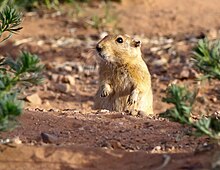| Fat sand rat Temporal range:
| |
|---|---|

| |
| A fat sand rat in Morocco | |
| Scientific classification | |
| Domain: | Eukaryota |
| Kingdom: | Animalia |
| Phylum: | Chordata |
| Class: | Mammalia |
| Order: | Rodentia |
| Family: | Muridae |
| Genus: | Psammomys |
| Species: | P. obesus
|
| Binomial name | |
| Psammomys obesus Cretzschmar, 1828
| |
The fat sand rat (Psammomys obesus) is a terrestrial mammal from the gerbil subfamily that is mostly found in North Africa and the Middle East, ranging from Mauritania to the Arabian Peninsula.[2] This species usually lives in sandy deserts, but may also be found in rocky terrain or saline marsh areas.[3] Fat sand rats are very selective in their diet, only eating stems and leaves of plants from the family Amaranthaceae, more commonly known as the amaranth family.[4] In captivity, fat sand rats can become obese and rapidly develop diabetes-like symptoms when fed the diet typically given to other rodents.[5][6] P. obesus has an average lifespan of 14 months in the wild and 3–4 years in captivity.[3]
- ^ Granjon, L. (2017) [errata version of 2016 assessment]. "Psammomys obesus". IUCN Red List of Threatened Species. 2016: e.T18418A115143282. doi:10.2305/IUCN.UK.2016-3.RLTS.T18418A22416093.en. Retrieved 25 February 2022.
- ^ Fichet-Calvet, E.; Jomâa, I.; Ismail, R. Ben; Ashford, R. W. (1999). "Reproduction and abundance of the fat sand rat (Psammomys obesus) in relation to weather conditions in Tunisia". Journal of Zoology. 248: 15–26. doi:10.1111/j.1469-7998.1999.tb01018.x.
- ^ a b Biagi, Tara. "Psammomys obesus (fat sand rat)". Animal Diversity Web. Retrieved 2020-01-21.
- ^ Daly, M.; Daly, S. (1973). "On the feeding ecology of Psamommys obesus (Rodentia, Gerbillidae) in the Wadi Saoura, Algeria" (PDF). Mammalia. 37 (4): 545–561. doi:10.1515/mamm.1973.37.4.545. S2CID 4073686.
- ^ Hackel, D. B.; Frohman, L; Mikat, E; Lebovitz, H. E.; Schmidt-Nielsen, K; Kinney, T. D. (1966). "Effect of diet on the glucose tolerance and plasma insulin levels of the fat sand rat (Psammomys obesus)". Diabetes. 15 (2): 105–14. doi:10.2337/diab.15.2.105. PMID 5907154. S2CID 5076992.
- ^ Kaiser, N; Cerasi, E; Leibowitz, G (2012). "Diet-Induced Diabetes in the Fat sand Rat (Psammomys obesus)". Animal Models in Diabetes Research. Methods in Molecular Biology. Vol. 933. pp. 89–102. doi:10.1007/978-1-62703-068-7_7. ISBN 978-1-62703-067-0. PMID 22893403.
